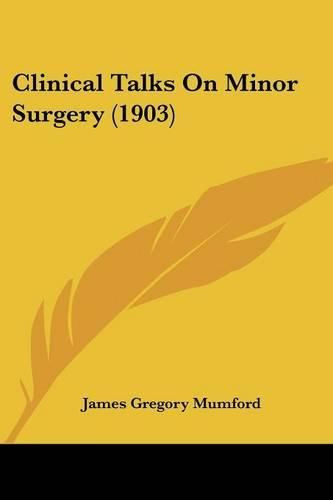Readings Newsletter
Become a Readings Member to make your shopping experience even easier.
Sign in or sign up for free!
You’re not far away from qualifying for FREE standard shipping within Australia
You’ve qualified for FREE standard shipping within Australia
The cart is loading…






Purchase of this book includes free trial access to www.million-books.com where you can read more than a million books for free. This is an OCR edition with typos. Excerpt from book: LECTURE V COMPOUND FRACTURES Gentlemen: In connection with the subject of lacerated wounds I must say something to-day about compound fractures. They are no more than special varieties of lacerated wounds. These fractures were regarded with extreme alarm in the old days, and are still not to be treated cavalierly. Chelius of Heidelberg wrote in 1821 that the inflammation is always very great and requires strict antiphlogistic treatment, blood-letting, leeches, cold applications, and opium, and that mortification and delirium tremens may occur, especially in old people.
If sleep do not take place death is the consequence. On dissection frequently there is exudation on the arachnoid, pus in the joints and in the sheaths of the tendons. All of which, of course, results from the fact that we have to deal with a lacerated and easily infected wound, which involves a structure of low vitality. Our effort therefore must always be to substitute a closed fracture for an open one, andthen to treat the damaged bone on the ordinary principles. Here again we come back to that matter of rigid asepsis and immobilization, the latter being of very great importance, for broken bones which are not held strictly at rest keep up an irritation of the wounded soft parts, delay healing, favor the continued outpouring of a sero-hemorrhagic exudate, and so provide a medium for the development of micro-organisms. The young woman whom I show you was jostled against a moving cart six days ago, and her arm, thrust between the spokes of the wheel, was severely mangled. On being brought in here shortly afterwards, it was found that both bones of the forearm were broken in the middle third and that the two upper fragments were protruding through a hole in the skin on the dorsum. The house surge…
$9.00 standard shipping within Australia
FREE standard shipping within Australia for orders over $100.00
Express & International shipping calculated at checkout
Purchase of this book includes free trial access to www.million-books.com where you can read more than a million books for free. This is an OCR edition with typos. Excerpt from book: LECTURE V COMPOUND FRACTURES Gentlemen: In connection with the subject of lacerated wounds I must say something to-day about compound fractures. They are no more than special varieties of lacerated wounds. These fractures were regarded with extreme alarm in the old days, and are still not to be treated cavalierly. Chelius of Heidelberg wrote in 1821 that the inflammation is always very great and requires strict antiphlogistic treatment, blood-letting, leeches, cold applications, and opium, and that mortification and delirium tremens may occur, especially in old people.
If sleep do not take place death is the consequence. On dissection frequently there is exudation on the arachnoid, pus in the joints and in the sheaths of the tendons. All of which, of course, results from the fact that we have to deal with a lacerated and easily infected wound, which involves a structure of low vitality. Our effort therefore must always be to substitute a closed fracture for an open one, andthen to treat the damaged bone on the ordinary principles. Here again we come back to that matter of rigid asepsis and immobilization, the latter being of very great importance, for broken bones which are not held strictly at rest keep up an irritation of the wounded soft parts, delay healing, favor the continued outpouring of a sero-hemorrhagic exudate, and so provide a medium for the development of micro-organisms. The young woman whom I show you was jostled against a moving cart six days ago, and her arm, thrust between the spokes of the wheel, was severely mangled. On being brought in here shortly afterwards, it was found that both bones of the forearm were broken in the middle third and that the two upper fragments were protruding through a hole in the skin on the dorsum. The house surge…